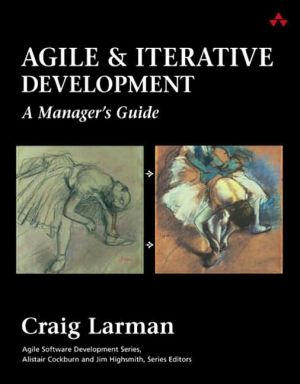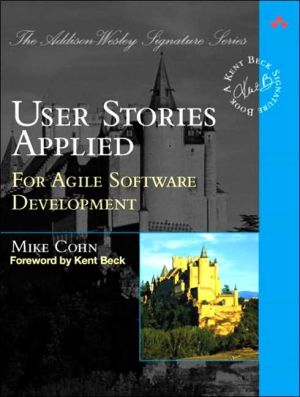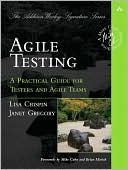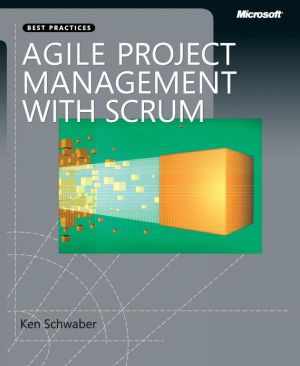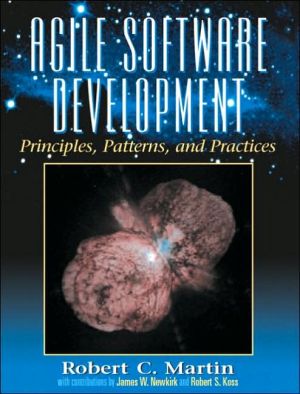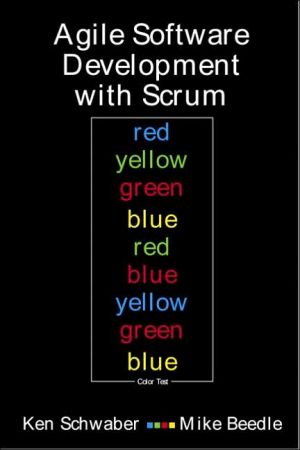Agile and Iterative Development (Agile Software Development Series): A Manager's Guide
Agile/iterative methods: From business case to successful implementation\ This is the definitive guide for managers and students to agile and iterative development methods: what they are, how they work, how to implement them—and why you should.\ Using statistically significant research and large-scale case studies, noted methods expert Craig Larman presents the most convincing case ever made for iterative development. Larman offers a concise, information-packed summary of the key ideas that...
Search in google:
Larman outlines the principles and best practices of iterative, evolutionary, and agile approaches to software development that emphasize collaboration and flexibility, illustrates those practices in an example system for tracking immigrants, and overviews the work products and core practices of the Scrum process, extreme programming, the unified process, and evolutionary project management (Evo). Annotation ©2003 Book News, Inc., Portland, OR
IntroductionOverview\ \ \ \ What's in this book?\ Predictable versus new product development.\ \ What value will you get from studying this book, an introduction to iterative and agile methods?\ First, you will know the key practices of four noteworthy methods, Scrum, Extreme Programming (XP), the Unified Process (UP), and Evo (one of the original iterative methods). This is a "Cliffs Notes" summary, each chapter has something useful to you as a manager, developer, or student of development methods.\ Second, your learning curve will be shortened, as this is a distilled learning aid. The four method chapters have the same structure, to speed comprehension and compare-contrast. There's a FAQ chapter, a "tips" chapter of common practices, and plenty of margin pointers to related pages—paper hyperlinks.\ Third, you will know motivation and evidence. Some organizations accept the value of iterative development, but others are still reluctant. If you need to make a case for an iterative project experiment, you will find in this book the key reasons, research, examples of large projects, standards-body acceptance, a business case, and promotion by well-known thought leaders through the decades. The research and history sections are also of value to students of software engineering methods.\ Note that agile methods are a subset of iterative methods; this book covers both types.\ The chapters may be read in any order; the big picture is this:\ \ 1. Introduction, and predictable vs. inventive development.\ 2. Basic iterative and evolutionary method practices.\ 3. Summary ofagile principles and methods.4. An agile project story to pull some ideas together.\ 5-6. Motivation and evidence chapters for iterative and agile methods; useful for some.\ 7-10. Four method summaries on Scrum, XP, UP, and Evo. Note: practices can be mixed.\ 11. A tips chapter that expands on some of the method practices, plus others.\ 12. A frequently asked questions (FAQ) chapter.\ \ Finally, people trump process. Every process book should probably include this standard disclaimer:\ Process is only a second-order effect. The unique people, their feelings, qualities, and communication are more influential.Some problems are just hard, some people are just difficult. These methods are not salvation.\ Software Is New Product Development\ Consider building mobile phones on an assembly line: It is possible to unambiguously define the specifications and construction steps. After building some phones and measuring things, it is possible to reliably estimate and schedule the building of future phones.\ A different problem: Build a custom house. The owner wants to use new environmentally friendly materials and methods, but isn't exactly sure what they want, and is going to change or clarify their decisions as they see the house, costs, and weeks unfold.\ At one end of the spectrum, such as manufacturing phones, there are problems with low degrees of novelty or change, and high rates of repeated identical or near-identical creation—mass manufacturing or predictable manufacturing.\ At the other end, there are problems with high degrees of novelty, creativity, and change, and no previous identical cases from which to derive estimates or schedules. This is the realm of new product development or inventive projects.\ The development process, management values, planning and estimation models appropriately associated with these two domains are different (Table 1.1).\ Of course, the point is,\ Most software is not a predictable or mass manufacturing problem. Software development is new product development.\ Plus, many projects use new and buggy technologies that exacerbate the degree of novelty and unpredictability. Note also it is a new product for the inexperienced even if it has been done before.\ Since predictable manufacturing is the wrong paradigm for software, practices and values rooted in it are not helpful.\ This mismatch lies at the heart of many of the challenges associated with traditional approaches to running a software project.A "waterfall" lifecycle, big up-front specifications, estimates, and speculative plans applicable to predictable manufacturing have been misapplied to software projects, a domain of inventive, high-change, high-novelty work.\ Factors CP86 preventing reliable up-front specifications include:\ \ The clients or users are not sure what they want.\ They have difficulty stating all they want and know.\ Many details of what they want will only be revealed during development.\ The details are overwhelmingly complex for people.\ As they see the product develop, they change their minds.\ External forces (such as a competitor's product or service) lead to changes or enhancements in requests.\ \ This deep appreciation—that building software is complex, new product development with high change rates, and not predictable manufacturing—is at the heart of the motivation for agile and iterative methods.\ Certainly, another driving force is the desire to compete and win. Iterative and agile methods foster flexibility and maneuverability—a competitive advantage. In Agile Competitors and Virtual Organizations GNP97 the authors examine the limitations of the mass manufacturing model and the need for agility:\ Agility ... is about succeeding and about winning: about succeeding in emerging competitive arenas, and about winning profits, market share, and customers in the very center of the competitive storms many companies now fear.\ What's Next?\ The next two chapters summarize basic practices and ideas of iterative, evolutionary, and agile methods. After that, a story chapter illustrates these practices with a concrete scenario.Web Resources\ Related book or journal article suggestions are given in their respective chapters. Web resource suggestions include:Broad Link or Article Sites\ www.agilealliance.com — Collects many articles specifically related to agile methods, plus links.\ www.cetus-links.org — The Cetus Links site has specialized for years in object technology (OT). Under "OO Project Management—OOA/D Methods" it has many links to iterative and agile methods, even though they are not directly related to OT.\ www.bradapp.net — Brad Appleton maintains a large collection of links on software engineering, including iterative methods.\ www.iturls.com — The Chinese front page links to an English version, with a search engine referencing iterative and agile articles. More Specific Sites\ c2.com/cgi/wiki?FindPage — This important, vast Wiki site was the home ground where many of the agile leaders (and design pattern leaders) held their original discussions on XP and other agile methods.\ www.extremeprogramming.org — Don Wells' (an early XP leader) introduction to XP.\ www.xprogramming.com — Ron Jeffries' (an early XP leader) introduction to XP.\ www.agilemodeling.com — Scott Ambler's site contains many articles related to agile modeling practices.\ sunset.usc.edu — Associated with the work of Dr. Barry Boehm, a long-time researcher into iterative (e.g., Spiral) methods. Articles related to iterative methods.\ www.cutter.com — Cutter's site has an Agile Project Management specialty area.\ www.martinfowler.com — Martin Fowler is an early agile methods thought leader (XP method). Articles and links.\ www.jimhighsmith.com — Jim Highsmith is an early agile methods thought leader (Adaptive Software Development method). Articles and links.\ alistair.cockburn.us — Alistair Cockburn is an early agile methods thought leader (Crystal methods). Articles and links.\ www.controlchaos.com — Ken Schwaber is an early agile methods thought leader (Scrum method). Articles and links.\ jeffsutherland.com — Jeff Sutherland is an early agile methods thought leader (Scrum method). Articles and links.\ www.gilb.com — Tom Gilb is one of the very earliest iterative and evolutionary thought leaders (Evo method). Articles and links.\ www.craiglarman.com — My site. Articles and links.\ www.objectmentor.com — Company led by Robert C. Martin, an early agile thought leader (XP related). Articles and links.\ www.nebulon.com — Company led by Jeff De Luca, an early agile thought leader (Feature-Driven Development method). Articles and links.\ www.dsdm.org — Official site for the DSDM method.\ www.rational.com — Official site for the Rational Unified Process (RUP) iterative method.name.case.unibz.it — Network for Agile Methodologies Experience (NAME). A European site that describes research into agile methods, and with links to other sites.
1Introduction12Iterative & Evolutionary93Agile254Story415Motivation496Evidence637Scrum1098Extreme Programming1379Unified Process17310Evo21111Practice Tips24712Frequently Asked Questions29713Bibliography329
